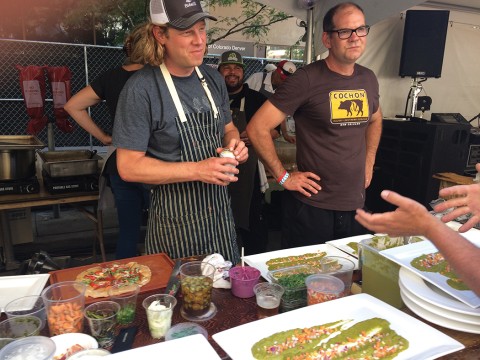A trash-to-table feast at Slow Food Nations
At the conference, chefs cooked for 100 of us using ingredients that were headed for the landfill.

On the cordoned-off street near Denver’s Larimer Square, a dozen chefs worked intently to prepare a dinner for about 100 people. Soon they began sending out plate after plate of gorgeous food: lightly pickled cherry tomatoes, okra, radishes, and turnips; chips and salsa; tuna escabeche; pork barbecue hash and baked beans; fried chicken wings; lentil stew with goat meat; and flatbreads topped with everything from prosciutto, tomatoes, and mozzarella to a bright fuchsia spread made with beet puree, cheese, and whey. And just when we thought we couldn’t possibly eat any more, out came the most perfect peach and cherry cobbler.
How was this meal different from all others? Every single dish was made entirely from garbage. Or, more precisely, “food waste.”
All of the excess food from the hundreds of workshops and conference events preceding the meal, though perfectly edible, would normally have gone straight into a garbage bag, then into a garbage truck, and then to a landfill. That’s what happens every day with food left over from restaurants, grocery stores, office parties, and personal refrigerators. Even the landfill is not a peaceful final resting place for food, as it festers there, releasing greenhouse gases. In fact, food waste is the third-largest source of carbon emissions, according to Food Chain Workers Alliance president Jose Oliva.





